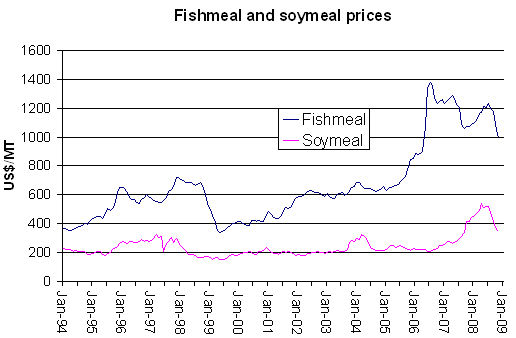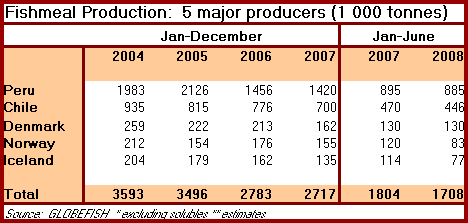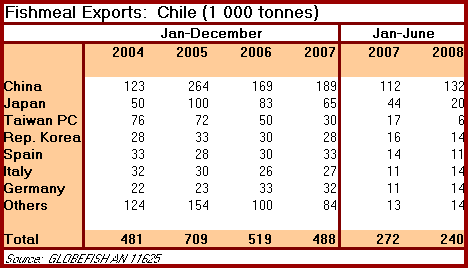Lower prices on the fishmeal market
However, despite of these limited catches, the overall 2008 production was reportedly also short on the corresponding 2007 level. This is creating some shortage on the market, while the previous year had been characterized by over-supply and declining prices.

The main market, China, came back with strong buying interest, which led to relatively high prices in the second quarter. China imported 170 000 tonnes of fish meal valued at US$ 195 million in September 2008, more than 50 per cent ahead of September 2007 imports. The import in January-September 2008 thus reached 1.16 million tonnes valued at US$ 1 188 million, up 42.8 per cent from the corresponding period of 2007.

The new Peruvian anchovy season started on 15 November. As in the previous year, 2 million tonnes quota were allocated for November and December. Results from the research cruise indicate that landings will mostly consist of adults. The lack of juveniles is creating concerns for the anchovy population next year. Imarpe estimates that the spawning would probably reach 50 per cent of normal as it was delayed all the way into November. Because of this worry, Imarpe took the unusual step to monitor also the developments of the anchovy during the mackerel research cruise later in November. Most seem to believe in a quota next year of about 5 million tonnes, which mirrors the 2008 fishing quota.
Lower production
Fishmeal production continued to decline in the course of the year. European producers are getting close to the end of the fishing season, therefore not much movement is experienced on the production side.

Peru managed to export higher quantities in 2008, after the difficult 2007. This recovery was caused by a strong Chinese market. In the first half of the year, Peru exported 860 000 tonnes, some 36 per cent more than last year. China took the lion’s share of this shipment, accounting for about half of Peruvian fishmeal exports. In 2007, China had been very reluctant to buy, as inventories had built up, at times reaching 200 000 tonnes. In 2008, however, these stocks had been used up, and the country came back as an eager buyer. While the Chinese aquaculture industry experienced some problems in the course of 2008 and the aquaculture feed production was less present as an importer of fishmeal, the pork industry was growing strongly. This was prompted by high prices of pork in the market.

The European fishmeal market continues very quiet. Buying interest was very low, during the period of high prices. German imports were 84 000 tonnes in the first half of 2008, some 30 per cent less than in the same period of 2007. This decline was caused by fewer exports from Peru.
Chile exported less fishmeal in 2008. In the first half of the year, total exports were 240 000 tonnes, a 10 per cent decline from the same period of 2007. While China was importing more Chilean fish.

In the second half of 2008 fishmeal prices tended downward significantly and fell below the US$ 1 000/tonne in November. Despite the strong demand in China, fishmeal prices dropped quite a bit in the last quarter of the year, in line with soybean and other protein meals.
Some downward movements in prices likely
The year 2009 is not expected to bring much increase in fishmeal production worldwide; on the contrary, some declines can be forecast. Price developments depend on the demand from China, as already experienced in previous years. There are some indications that at least in the opening months of the year this market will buy less, which should lead to somewhat lower prices.
December 2008


